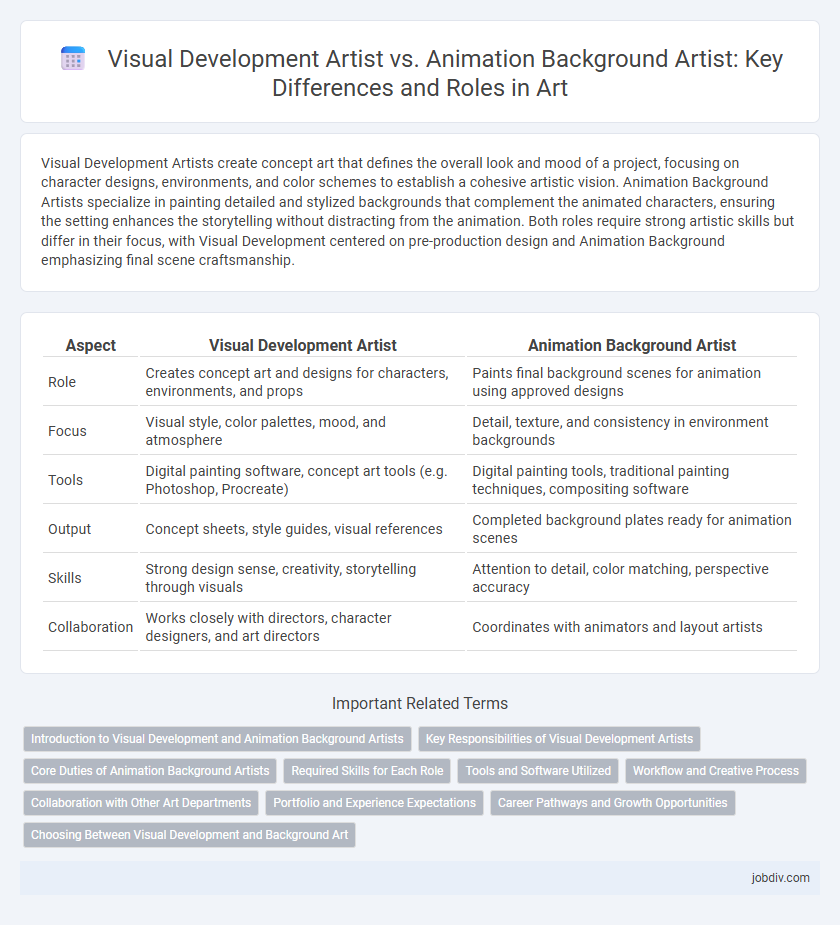Visual Development Artists create concept art that defines the overall look and mood of a project, focusing on character designs, environments, and color schemes to establish a cohesive artistic vision. Animation Background Artists specialize in painting detailed and stylized backgrounds that complement the animated characters, ensuring the setting enhances the storytelling without distracting from the animation. Both roles require strong artistic skills but differ in their focus, with Visual Development centered on pre-production design and Animation Background emphasizing final scene craftsmanship.
Table of Comparison
| Aspect | Visual Development Artist | Animation Background Artist |
|---|---|---|
| Role | Creates concept art and designs for characters, environments, and props | Paints final background scenes for animation using approved designs |
| Focus | Visual style, color palettes, mood, and atmosphere | Detail, texture, and consistency in environment backgrounds |
| Tools | Digital painting software, concept art tools (e.g. Photoshop, Procreate) | Digital painting tools, traditional painting techniques, compositing software |
| Output | Concept sheets, style guides, visual references | Completed background plates ready for animation scenes |
| Skills | Strong design sense, creativity, storytelling through visuals | Attention to detail, color matching, perspective accuracy |
| Collaboration | Works closely with directors, character designers, and art directors | Coordinates with animators and layout artists |
Introduction to Visual Development and Animation Background Artists
Visual Development Artists create concept art and establish the overall aesthetic of characters, environments, and props to guide the animation process, often working closely with directors and art directors. Animation Background Artists specialize in painting the static backgrounds seen in scenes, ensuring consistency in color, style, and atmosphere that complement the story and character actions. Both roles are essential in animation production, with Visual Development Artists shaping initial visual concepts and Animation Background Artists bringing those environments to life.
Key Responsibilities of Visual Development Artists
Visual Development Artists specialize in designing the overall look and feel of characters, environments, and props through concept art and color scripts that guide the animation process. They create mood boards, key sketches, and detailed illustrations to establish the visual style and emotional tone for films or games. Their work aligns closely with directors and production designers to ensure cohesive storytelling and visual consistency throughout the project.
Core Duties of Animation Background Artists
Animation Background Artists specialize in creating the environments where animated scenes take place, focusing on designing detailed, immersive settings that enhance storytelling. Their core duties include painting backgrounds that establish mood, perspective, and spatial context, ensuring consistency with the visual style of the animation. They collaborate closely with visual development artists to align scenic elements with character actions and narrative flow.
Required Skills for Each Role
Visual Development Artists excel in conceptualizing characters, environments, and color schemes, requiring advanced skills in digital painting, illustration, and strong understanding of lighting and composition. Animation Background Artists focus on creating detailed, consistent backgrounds that support the storytelling, demanding expertise in perspective, architectural drawing, and seamless integration with animated elements. Both roles require proficiency in software like Photoshop and an eye for visual storytelling, but Visual Development Artists emphasize creativity and mood-setting, while Animation Background Artists prioritize accuracy and continuity.
Tools and Software Utilized
Visual Development Artists primarily utilize software such as Adobe Photoshop, Corel Painter, and Procreate to create concept art, character designs, and environments that establish the artistic direction of a project. Animation Background Artists rely on tools like Toon Boom Harmony, Adobe Animate, and Photoshop to craft detailed backgrounds that complement animated sequences and maintain visual consistency. Both roles require proficiency in digital painting and illustration software but differ in their focus on pre-visualization versus final background execution.
Workflow and Creative Process
Visual Development Artists focus on conceptualizing characters, environments, and overall aesthetics early in the production, using sketches and color studies to establish the visual tone. Animation Background Artists translate these concepts into detailed, static backgrounds that support the narrative flow and match the animation style. Their workflow emphasizes precision in perspective and consistency to enhance storytelling without distracting from animated motion.
Collaboration with Other Art Departments
Visual Development Artists collaborate closely with character designers, colorists, and concept artists to establish cohesive visual styles and mood boards that guide the entire animation pipeline. Animation Background Artists work alongside layout artists, lighting technicians, and compositors, ensuring backgrounds align seamlessly with character movements and scene composition. Effective communication and shared asset management between these roles enhance the overall aesthetic consistency and storytelling impact of the animation project.
Portfolio and Experience Expectations
A Visual Development Artist portfolio highlights concept art, character design, and environment creation, demonstrating strong storytelling skills and versatility in style. Experience often includes collaboration on pre-production phases with a focus on mood-setting, color theory, and ideation. An Animation Background Artist portfolio emphasizes detailed backgrounds, perspective accuracy, and consistency to support narrative flow, with experience centered on painting environments and maintaining visual continuity throughout animation sequences.
Career Pathways and Growth Opportunities
Visual Development Artists specialize in creating concept art, character designs, and environments that define the overall look and feel of an animation or game, often leading to roles in art direction or creative leadership. Animation Background Artists focus on painting detailed settings that support the storytelling, which can evolve into senior background painting or environment design positions. Both career paths require mastery of artistic techniques and software, with growth opportunities influenced by portfolio strength, industry networking, and adaptability to emerging digital tools.
Choosing Between Visual Development and Background Art
Choosing between a Visual Development Artist and an Animation Background Artist hinges on your passion for concept creation versus environmental detailing. Visual Development Artists focus on designing characters, settings, and props that define the artistic style and narrative tone of a project. Animation Background Artists specialize in crafting detailed environmental backdrops that establish mood and continuity, making them crucial for immersive storytelling in animated films and games.
Visual Development Artist vs Animation Background Artist Infographic

 jobdiv.com
jobdiv.com